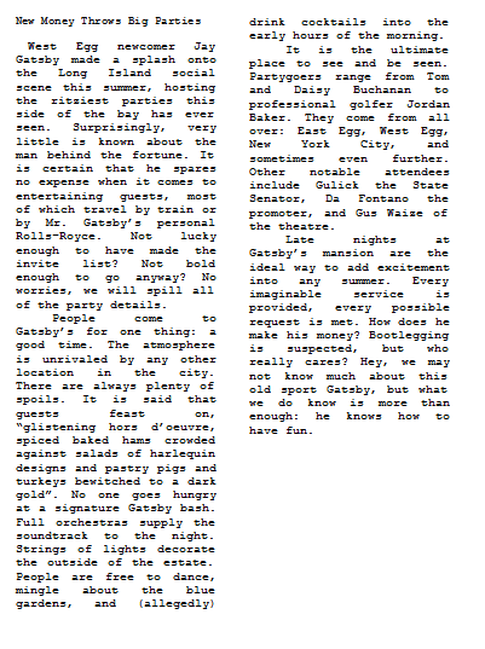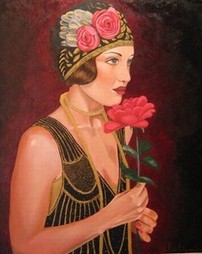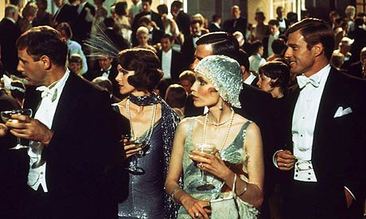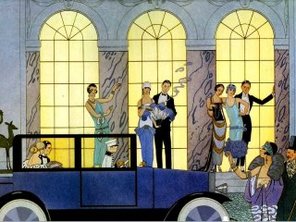Town Tattle
Waiting for car repairs is boring
Pass the time by catching up on all of New York society's latest and most scandalous gossip
Pass the time by catching up on all of New York society's latest and most scandalous gossip
In chapter two of The Great Gatsby, Myrtle picks up a copy of Town Tattle at a New York news-stand. Later in the apartment, Town Tattle is again referenced along with Simon Called Peter and the small scandal magazines of Broadway. All three are examples of gossip literature popular in the 1920s. Modern day magazine equivalents are publications such as People Magazine or US Weekly. They mostly featured rumors and news about high society rather than the traditional celebrity. The modern film and Hollywood stars gained more momentum during the 1950s. The 1920s had limited radio broadcasting and no television, which can be attributed to the popularity of magazines and increased interest in the lives of the upper class.
Simon Called Peter is a novel, not a magazine. It was written by Robert Keable and a bestseller during the year 1921. The wartime story was controversial for its religious and sexual content. The book serves as an index for Myrtle's vulgarity, in addition to her possession of numerous scandalous magazines. When Nick finds himself alone with the book he, "sat down discreetly in the living-room and read a chapter of Simon Called Peter --- either it was terrible stuff or the whiskey distorted things, because it didn't make sense" (29). Nick's reaction serves as yet another example of distaste for the novel.
Myrtle represents a section of society with aspirations of living the high life. She reads in print what Gatsby, Tom, and Daisy are actually living. The Great Gatsby focuses on affluence, but the 1920s was also marked by the struggles of under represented minorities, overcrowded cities, government corruption, and organized crime. Fitzgerald portrays the era as one of excessive greed achieved by any means.
------------------------------------------------------------------------------------------------------------------------------------------------------------------------------------------------------------------------------------------------
The article I wrote focuses on both the intrigue and indifference surrounding Gatsby. It is from the perspective of the average party-goer who has no knowledge of the man throwing the parties, and may not have been invited in the first place. Guests use and abuse Gatsby's home. They care little about him and only about the dancing, drinking, and socializing:
"As soon as I arrived I made an attempt to find my host, but the two or three people of whom I asked his whereabouts stared at me in such an amazed way.." (42)
I chose this genre of media because I was interested in the magazine titles when I first read them in The Great Gatsby. The subject of Jay Gatsby seemed like a perfect topic for a gossip magazine because his parties were so well attended and popular throughout the Long Island area. The book provided many descriptions of the party setting and guests, which allowed me to write the article. Almost the entirety of Chapter III provided apt descriptions:
"Every Friday five crates of oranges and lemons arrived from a fruiterer in New York" (39)
"no thin five-piece affair, but a whole pitful of oboes and trombones and saxophones and viols and cornets and piccolos, and low and high drums" (40)






